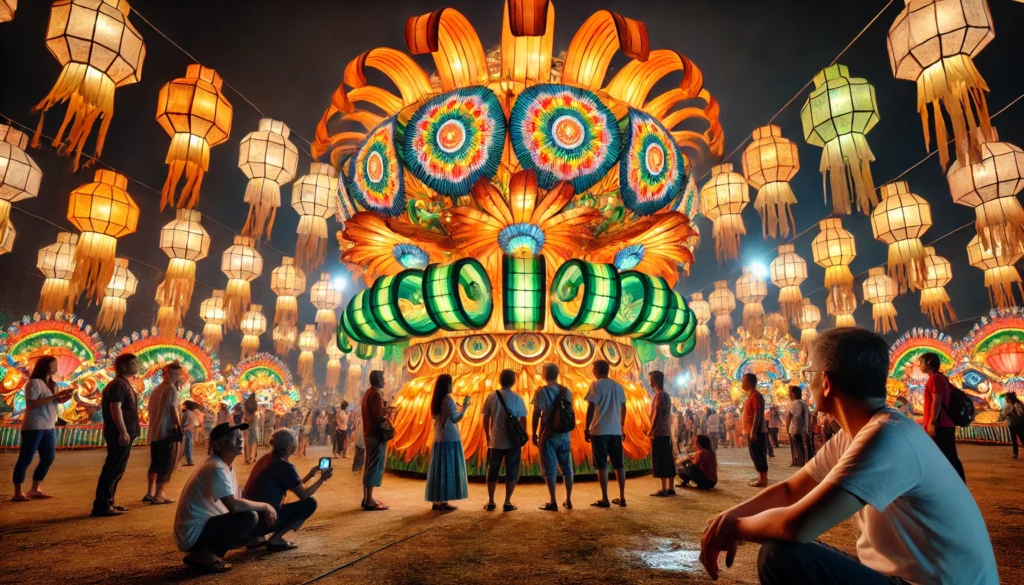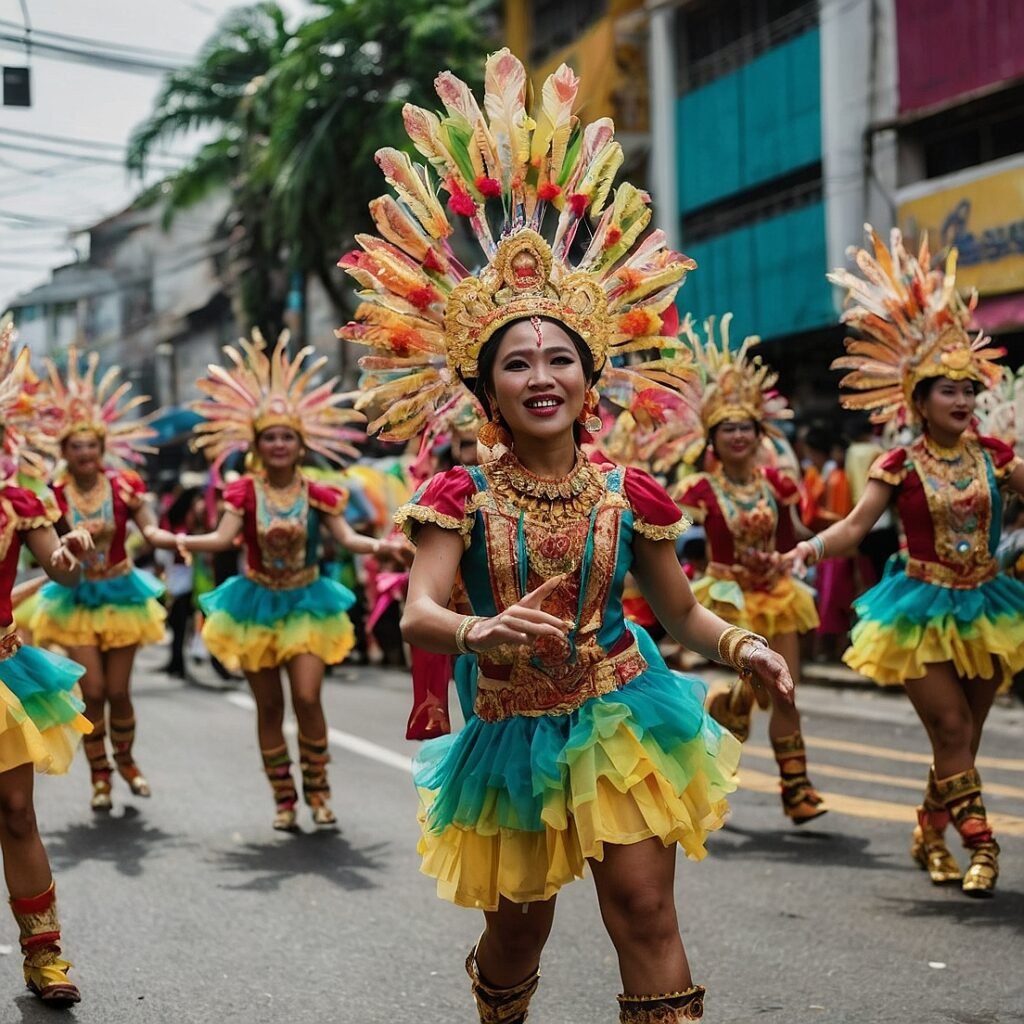Picture this: a balmy evening in the Philippines, the air filled with excitement and anticipation. Suddenly, the night sky comes alive with an explosion of colors, patterns, and intricate designs. No, it’s not fireworks – it’s something even more magical. Welcome to the Giant Lantern Festival, a dazzling spectacle that has been captivating visitors for over a century. This isn’t your average lantern festival; we’re talking about massive, elaborate creations that tower over spectators and light up the night like miniature suns. If you’ve never heard of this incredible event before, buckle up because you’re in for a treat! In this blog post, we’ll dive deep into the world of the Giant Lantern Festival, exploring its rich history, cultural significance, and the sheer artistry that goes into creating these awe-inspiring displays. So, grab a cup of coffee (or a cold glass of halo-halo if you’re feeling tropical), and let’s embark on a journey to one of the Philippines’ most enchanting celebrations!
The Origins: A Twinkling Tale of Tradition
From Humble Beginnings to Spectacular Displays
Every great story has a beginning, and the Giant Lantern Festival is no exception. This beloved tradition traces its roots back to the early 1900s in the city of San Fernando, Pampanga – a place that would eventually earn the nickname “Christmas Capital of the Philippines.” But hold your horses; we’re not talking about Christmas trees and Santa Claus here. The festival’s origins are deeply intertwined with Filipino Catholic traditions, particularly the nine-day novena leading up to Christmas known as Simbang Gabi or Misa de Gallo.
Back in those days, folks would carry small paper lanterns to light their way to church for these pre-dawn masses. It was a practical solution to navigate dark streets, but it also added a touch of magic to the early morning proceedings. As time went on, these humble lanterns began to grow – both in size and complexity. The people of San Fernando, known for their creativity and craftsmanship, started to put their own spin on the tradition. They began creating larger, more elaborate lanterns to decorate the town square and church entrances during the Christmas season.
The Evolution of a Spectacle
Now, you might be wondering how we got from simple paper lanterns to the jaw-dropping creations we see today. Well, it’s a classic tale of friendly competition and community pride. As the lanterns grew bigger and more intricate, different barangays (neighborhoods) in San Fernando started to vie for the title of the most impressive display. This friendly rivalry sparked innovation and pushed the boundaries of what was possible with lantern design.
By the 1930s, the lanterns had reached a size of about 4 feet in diameter – impressive for the time, but still modest compared to today’s giants. The real game-changer came in 1931 when electricity entered the picture. Suddenly, lantern makers could incorporate light bulbs into their designs, creating dynamic displays that could blink, sparkle, and dance in ways that were previously unimaginable. This technological leap catapulted the Giant Lantern Festival into a whole new realm of artistic expression.
The Art of Giant Lantern Making: Where Tradition Meets Innovation
Crafting a Masterpiece: Materials and Techniques
Creating a giant lantern isn’t just a matter of scaling up a small design. It’s a complex process that requires a unique blend of traditional craftsmanship and modern technology. The basic structure of these behemoths typically starts with bamboo or steel frames, which provide the skeleton for the lantern. From there, artisans cover the frame with a variety of materials, including paper, plastic, capiz shells (a type of translucent shell native to the Philippines), and even fiberglass.
But the real magic happens when it comes to the lighting. Modern giant lanterns can contain anywhere from 3,000 to a staggering 10,000 light bulbs! These aren’t just static lights, either. Lantern makers use sophisticated electrical systems to create intricate moving patterns and color changes. It’s like a massive, three-dimensional LED screen, but with a warmth and charm that only handcrafted art can provide.
The Masters Behind the Magic
Behind every stunning lantern is a team of skilled artisans, each specializing in different aspects of the craft. You’ve got your framework builders, who construct the sturdy base. Then there are the designers who plan out the intricate patterns and motifs. Electricians work their magic to bring the lanterns to life with complex lighting sequences. And let’s not forget the artists who painstakingly apply decorative elements to create texture and depth.
Many of these skills are passed down through generations, with families in San Fernando taking pride in their lantern-making heritage. It’s not uncommon to find workshops where grandparents, parents, and children all work side by side, each contributing their expertise to create these luminous marvels.
The Festival Experience: A Night of Lights and Delights
A Feast for the Senses
Attending the Giant Lantern Festival is like stepping into a wonderland of light and color. As the sun sets and darkness falls, the anticipation builds. Then, with a flick of a switch, the night explodes into a kaleidoscope of twinkling, shimmering brilliance. Each lantern, some towering up to 20 feet tall, becomes a canvas for intricate designs that often tell stories from Philippine history, folklore, or religious traditions.
But it’s not just about the visual spectacle. The festival is a full sensory experience. The air is filled with the excited chatter of spectators, the occasional “oohs” and “aahs” as a particularly impressive display lights up. The scent of Filipino street food wafts through the crowd – think sizzling barbecue, sweet bibingka (rice cakes), and steaming cups of tsokolate (hot chocolate). It’s a feast for all the senses, creating memories that last long after the lights have dimmed.
More Than Just Lanterns
While the giant lanterns are undoubtedly the stars of the show, the festival offers much more than just luminous displays. Street performances, live music, and cultural presentations add to the festive atmosphere. Local artisans set up stalls selling traditional crafts, giving visitors a chance to take a piece of Pampanga’s artistic heritage home with them.
For food lovers, the festival is a golden opportunity to sample some of Pampanga’s famous cuisine. The province is known as the culinary capital of the Philippines, and local chefs and home cooks alike pull out all the stops during the festival. From classic dishes like sisig (a sizzling pork dish) to innovative fusion creations, there’s something to tantalize every palate.
The Competition: Where Creativity Meets Community Pride
Battle of the Barangays
At the heart of the Giant Lantern Festival is a friendly but fierce competition between the participating barangays. Each year, these communities pour their hearts, souls, and considerable resources into creating the most spectacular lantern possible. The competition isn’t just about who can make the biggest or brightest lantern – it’s about creativity, storytelling, and pushing the boundaries of what’s possible with light and design.
Judges evaluate the lanterns based on several criteria, including originality, design complexity, and the synchronization of lights to music. Yes, you read that right – many of these lanterns are programmed to “dance” to music, adding yet another layer of complexity and artistry to the displays.
More Than Just a Contest
While the competitive aspect adds excitement to the festival, it’s important to note that the Giant Lantern Festival is about much more than winning a prize. It’s a celebration of community spirit, cultural heritage, and artistic expression. The months of preparation leading up to the festival bring neighbors together, strengthening community bonds. Young people work alongside their elders, learning valuable skills and keeping traditions alive.
Moreover, the festival has become a source of pride and identity for San Fernando and the entire province of Pampanga. It’s a way for the community to showcase their creativity and craftsmanship to the world, attracting visitors from across the Philippines and beyond.
The Economic Impact: Lighting Up Local Livelihoods
Boosting Tourism and Local Businesses
The Giant Lantern Festival isn’t just a cultural phenomenon; it’s also a significant economic driver for San Fernando and the surrounding areas. Each year, the festival attracts thousands of visitors, providing a welcome boost to local businesses. Hotels, restaurants, transportation services, and souvenir shops all benefit from the influx of tourists eager to experience the spectacle.
But the economic impact goes beyond just tourism. The lantern-making industry itself provides livelihoods for hundreds of skilled artisans and their families. From sourcing materials to crafting the lanterns and maintaining them throughout the festival season, it’s a labor-intensive process that creates jobs and supports local suppliers.
Preserving Traditional Skills in a Modern Economy
In an era of rapid technological advancement and changing economic landscapes, the Giant Lantern Festival plays a crucial role in preserving traditional crafts and skills. The knowledge required to create these massive, intricate lanterns is a unique blend of artistry and engineering that has been honed over generations. By providing a platform for these skills to be showcased and celebrated, the festival ensures that they remain relevant and valued in the modern world.
Furthermore, the festival has inspired spin-off industries and year-round lantern-making businesses. Some artisans have found success creating smaller lanterns or applying their skills to other forms of light-based art and decoration, expanding the economic benefits beyond just the festival season.
The Global Stage: From Local Tradition to International Attraction
Putting San Fernando on the World Map
What started as a local tradition has now become an internationally recognized event, drawing visitors and media attention from around the globe. The Giant Lantern Festival has been featured in numerous travel shows, documentaries, and international publications, helping to put San Fernando and Pampanga on the world tourism map.
This global recognition hasn’t just boosted tourism; it’s also instilled a sense of pride in the local community. Seeing their cultural heritage celebrated on an international stage has reinforced the importance of preserving and promoting these traditions for future generations.
Cultural Exchange and Inspiration
The success of the Giant Lantern Festival has inspired similar events in other parts of the Philippines and even in Filipino communities abroad. It’s become a symbol of Filipino creativity and craftsmanship, showcasing the country’s rich cultural heritage to the world.
Moreover, the festival has facilitated cultural exchange, with lantern makers from San Fernando occasionally invited to participate in events or exhibitions in other countries. This cross-pollination of ideas and techniques has led to innovations in lantern design and has helped to keep the tradition dynamic and evolving.
Challenges and Innovations: Keeping the Lights On
Adapting to Changing Times
Like any long-standing tradition, the Giant Lantern Festival has faced its share of challenges over the years. From economic downturns to natural disasters (Pampanga was severely affected by the eruption of Mount Pinatubo in 1991), the festival has had to adapt and evolve to survive.
One of the ongoing challenges is balancing tradition with innovation. While there’s a strong desire to preserve the authentic character of the lanterns, there’s also pressure to incorporate new technologies and designs to keep the festival fresh and exciting. Lantern makers have responded by experimenting with new materials, more energy-efficient lighting systems, and even incorporating elements of augmented reality into their displays.
Environmental Considerations
In recent years, there’s been a growing awareness of the environmental impact of the festival. The energy consumption of thousands of light bulbs and the materials used in lantern construction have raised concerns about sustainability. In response, organizers and lantern makers have been exploring more eco-friendly options, such as LED lights and recycled materials.
Some lantern makers have even started incorporating environmental messages into their designs, using the festival as a platform to raise awareness about issues like climate change and conservation.
The Future of the Giant Lantern Festival: Bright Lights Ahead
Nurturing the Next Generation
As we look to the future of the Giant Lantern Festival, one of the key priorities is ensuring that the skills and traditions are passed down to younger generations. Many lantern-making families are actively involving their children in the craft, and there have been initiatives to introduce lantern-making workshops in local schools.
The festival organizers are also exploring ways to make the event more engaging for younger audiences, incorporating elements of social media and interactive technologies to appeal to the digital native generation.
Expanding the Festival’s Reach
While the Giant Lantern Festival remains firmly rooted in San Fernando, there are efforts to expand its reach and impact. This includes satellite events in other parts of the Philippines, traveling exhibitions, and collaborations with other light-based festivals around the world.
There’s also potential for the festival to become a platform for broader cultural exchange, showcasing not just lantern-making but other aspects of Filipino art, music, and cuisine to an international audience.
A Beacon of Filipino Culture and Creativity
As we wrap up our journey through the dazzling world of the Giant Lantern Festival, it’s clear that this event is so much more than just a spectacular light show. It’s a living, breathing testament to Filipino creativity, community spirit, and cultural resilience. From its humble beginnings as a way to light the path to church, to its current status as an internationally recognized spectacle, the festival has continually evolved while staying true to its roots.
The Giant Lantern Festival reminds us of the power of tradition to bring people together, spark innovation, and illuminate the best aspects of a culture. It’s a celebration of light in all its forms – the light of creativity, of community, and of the human spirit. So, whether you’re planning your next trip to the Philippines or simply dreaming of faraway festivals, keep the Giant Lantern Festival of San Fernando in mind. It’s more than just a feast for the eyes; it’s an experience that will light up your soul long after the last bulb has dimmed.
Here’s a table summarizing some key facts about the Giant Lantern Festival:
| Aspect | Details |
|---|---|
| Location | San Fernando, Pampanga, Philippines |
| Nickname | Christmas Capital of the Philippines |
| Origin | Early 1900s |
| Originally Used For | Lighting the way to pre-dawn masses |
| Lantern Size | Up to 20 feet tall |
| Number of Bulbs | 3,000 to 10,000 per lantern |
| Main Materials | Bamboo, steel, paper, plastic, capiz shells |
| Key Features | Intricate designs, synchronized light patterns |
| Economic Impact | Boosts tourism, supports local artisans |
| Cultural Significance | Preserves traditional skills, promotes Filipino culture |
Disclaimer: This blog post is based on information available up to 2021. While we strive for accuracy, details about the Giant Lantern Festival may have changed since then. If you notice any inaccuracies, please report them so we can correct them promptly. Always check official sources for the most up-to-date information when planning to attend the festival.




